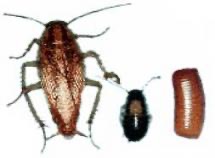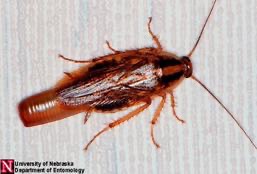Cockroaches on Discovery
The German Cockroach

The most common cockroach found in homes, apartments, restaurants, supermarkets, hospitals and other buildings where food is stored, prepared or served. They are carnivorous insects feeding on its own at times. They eat human and animal feces, food of all kinds and may hitchhike into dwellings on egg cartons, soft drinks cartons, sacks of rice, potatoes or onions, used furniture, beer cases, storage boxes, etc. These cockroaches will move from building to building during the warm summer months. They can develop into large populations and live throughout the home, especially in kitchens and bathrooms. One (1) female roach can produce an infestation of 300,000 german roaches in one year. Cockroaches can foul food and produce an unpleasant odor. A significant number of people are allergic to cockroaches, and may exhibit chronic symptoms without realizing the cause of there watery eyes or runny noses. Cockroaches can also contaminate food with bacteria that can cause food poisoning, dysentery, or diarrhea. Eliminating roaches is very important, as they pose a major health risk Roaches travel about and eat any waste and food products, including as stated above human and animal feces. This means they can easily transmit disease with viruses and bacteria. In fact, at least 100 species of bacteria have been isolated from cockroaches, such as Salmonella, E. Coli, and Shigella.
Life Cycle and Habits of The German Cockroach

German cockroach females, unlike most other cockroaches, carry ootheca (egg case) that protrude from their abdomen until the eggs are ready to hatch. The ootheca is then dropped in a secluded location, where the nymphs emerge within one day. A female may produce four to eight cases during her lifetime, each containing 30 to 48 eggs. Eggs hatch in about one month, and nymphs develop in 1-1/2 to 4 months. Adult female cockroaches live about 6-1/2 months and males live slightly less.
The German cockroach produces more eggs and has more generations per year (three to four) than other cockroaches, thus troublesome infestations can develop from a few individuals. This cockroach has spread throughout the world by commerce and transportation. It is the most prevalent pest in apartments in the United States. During the day, these cockroaches hid in clusters behind baseboard molding, in cracks around cabinets, closets or pantries, behind wall hangings and pictures, and in and under stoves, refrigerators and dishwashers. The crevices behind kitchen drawers and beneath the sink are one of the primary cockroach harbor ages. If clusters of cockroaches are seen during the day, the population is large. Both nymphs and adults are very active and capable of running rapidly. Without food and water adults may die in two weeks. However, they can live with only water for up to a month.
Common Myths
- A cockroach problem is a sign of a dirty home.
Once again this is wrong. Cockroaches will live in clean homes, however larger colonies are often found in unclean homes due to the increased food source available. - All cockroaches lay several egg sacs a month.
Inaccurate. The German cockroach will normally only lay one sac per month, however each sac can hold approximately 40 babies. - There are albino cockroaches.
This is false, the reality is that cockroaches shed their skin and for a few hours, while the new skin dries, they are white in color. - Cockroaches are active all night.
Once again not entirely true. Cockroaches are actually very lazy and in general will only stay active for approximately 4 hours during the night.
German Cockroach Biology
Identification
Most cockroaches have a flattened, oval shape, spiny legs, and long filamentous antennae. Immature stages are smaller, have undeveloped wings and resemble the adults. Adult German cockroaches are light tan to medium brown except for the shield behind the bead marked with two dark stripes (separated by a lighter stripe), which run lengthwise on the body. Adults are about 1/2 to 5/8 inch long, have wings, but rarely fly. Wings cover the entire abdomen of the females and all except the abdominal tip in the bales. The male is light brown and rather boat-shaped. Whereas the female is slightly darker with a broader behind. Young cockroaches (nymphs) develop through 6 to 7 stages (instars) over 74 to 85 days (varying with temperature) nymphs hatching from eggs are less than 1/8 inch long are wingless and nearly black with a single light stripe, separating two black bands, running down about halfway of the middle of the back. Egg capsules (ootheca) are light tan and about 1/4 inch long.
Preventing Infestation of German Roaches
There are many control strategies available to help solve cockroach problems. Cockroach control requires more than just insecticides. You will be most successful if you use a combination of methods. Preventing access to shelter, food, and water around your home is one of the best control measures both outside and inside.
Outdoor habitat changes that may help include:
- Remove as much mulch or debris around the building as possible. Prune tree limbs and shrubbery so they do not touch the house. Stack wood away from the house and raise the piles off the ground.
- If you have pets, do not leave food bowls out overnight and keep kennel areas clean.
- Dispose of garbage in sealed bags and in garbage cans with lids. If you recycle, rinse out cans and bottles, and keep your recycling areas in a dry location away from the house. Do not let your recycling area become too cluttered.
- Keep screens and weather stripping in good repair. Check attic vents and windows. Caulk large openings around outside drainage lines and sewer vents. Steel wool can be used as a temporary filler until you can caulk openings properly.
- Remember to check grocery bags, boxes, firewood, and other items that may serve as a means of entry for cockroaches.
If cockroaches do get inside, the following tips will help you control them:
- Keep food and garbage in tight containers.
- Clean up all crumbs and spills on floors, counters, and shelves as soon as they occur.
- Keep faucets and drains under sinks and appliances in good repair. Do not let water stand in the sink for long periods of time.
- Keep clutter from accumulating, especially in kitchens and bathrooms. Cockroaches often hide in messy cabinets and in stacks of newspapers, bags, and rags.
- Vacuum and sweep floors often. Vacuuming is very important because it can remove small food crumbs, and cockroach egg-cases that may not be killed by insecticides.
- Good sanitation is important, both inside and outside the house. It is often the best control measure for cockroaches.
Hiring Pest Management Professionals
Despite the fact that a variety of assumptions made about the cockroach are actually inaccurate, we must not forget the fact that they are unhygienic pests with the potential to spread disease and cause damage within your home. Cockroaches have the potential to breed very quickly so it is important to consider treatment at the first sign of a problem. Getting a pest management professional (PMP) involved as soon as possible rather than taking time to try to treat the problem yourself, they are very effective at preventing further infestations. Each pest management company should have instructions for residents on how to prepare the unit for treatment which will include laundering and cleaning.